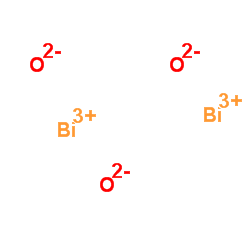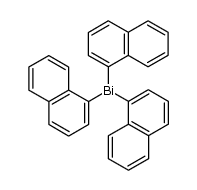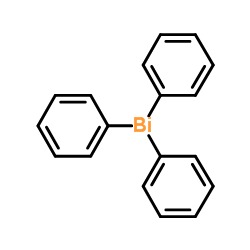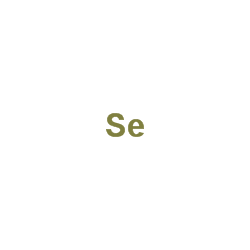Bismuth trioxide

Bismuth trioxide structure
|
Common Name | Bismuth trioxide | ||
|---|---|---|---|---|
| CAS Number | 1304-76-3 | Molecular Weight | 465.959 | |
| Density | 8.9 | Boiling Point | 1890°C | |
| Molecular Formula | Bi2O3 | Melting Point | 825 °C | |
| MSDS | Chinese USA | Flash Point | 1890°C | |
| Name | Bismuth trioxide |
|---|---|
| Synonym | More Synonyms |
| Density | 8.9 |
|---|---|
| Boiling Point | 1890°C |
| Melting Point | 825 °C |
| Molecular Formula | Bi2O3 |
| Molecular Weight | 465.959 |
| Flash Point | 1890°C |
| Exact Mass | 465.945557 |
| Stability | Stable. |
| Water Solubility | INSOLUBLE |
Synonym:Bismuth trioxide; Bismuthous oxide; Bismuth yellow Section 2 - COMPOSITION, INFORMATION ON INGREDIENTS
Risk Phrases: None Listed. Section 3 - HAZARDS IDENTIFICATION EMERGENCY OVERVIEW
Not available. Potential Health Effects Eye: May cause eye irritation. Skin: May cause skin irritation. Ingestion: May cause irritation of the digestive tract. May cause liver and kidney damage. Inhalation: May cause respiratory tract irritation. Chronic: May cause liver and kidney damage. Section 4 - FIRST AID MEASURES Eyes: Flush eyes with plenty of water for at least 15 minutes, occasionally lifting the upper and lower eyelids. Get medical aid. Skin: Flush skin with plenty of water for at least 15 minutes while removing contaminated clothing and shoes. Get medical aid if irritation develops or persists. Wash clothing before reuse. Ingestion: Get medical aid. Do NOT induce vomiting. If conscious and alert, rinse mouth and drink 2-4 cupfuls of milk or water. Inhalation: Remove from exposure and move to fresh air immediately. If not breathing, give artificial respiration. If breathing is difficult, give oxygen. Get medical aid if cough or other symptoms appear. Notes to Physician: Section 5 - FIRE FIGHTING MEASURES General Information: As in any fire, wear a self-contained breathing apparatus in pressure-demand, MSHA/NIOSH (approved or equivalent), and full protective gear. Extinguishing Media: Use extinguishing media most appropriate for the surrounding fire. Section 6 - ACCIDENTAL RELEASE MEASURES General Information: Use proper personal protective equipment as indicated in Section 8. Spills/Leaks: Vacuum or sweep up material and place into a suitable disposal container. Clean up spills immediately, observing precautions in the Protective Equipment section. Avoid generating dusty conditions. Provide ventilation. Section 7 - HANDLING and STORAGE Handling: Wash thoroughly after handling. Use with adequate ventilation. Minimize dust generation and accumulation. Avoid contact with eyes, skin, and clothing. Keep container tightly closed. Avoid ingestion and inhalation. Storage: Store in a tightly closed container. Section 8 - EXPOSURE CONTROLS, PERSONAL PROTECTION Engineering Controls: Facilities storing or utilizing this material should be equipped with an eyewash facility and a safety shower. Use adequate ventilation to keep airborne concentrations low. Exposure Limits CAS# 1304-76-3: Personal Protective Equipment Eyes: Wear appropriate protective eyeglasses or chemical safety goggles as described by OSHA's eye and face protection regulations in 29 CFR 1910.133 or European Standard EN166. Skin: Wear appropriate protective gloves to prevent skin exposure. Clothing: Wear appropriate protective clothing to minimize contact with skin. Respirators: A respiratory protection program that meets OSHA's 29 CFR 1910.134 and ANSI Z88.2 requirements or European Standard EN 149 must be followed whenever workplace conditions warrant respirator use. Section 9 - PHYSICAL AND CHEMICAL PROPERTIES Physical State: Solid Color: yellow Odor: odorless pH: Not available. Vapor Pressure: Not available. Viscosity: Not available. Boiling Point: Not available. Freezing/Melting Point: 825 deg C Autoignition Temperature: Not applicable. Flash Point: Not applicable. Explosion Limits, lower: Not available. Explosion Limits, upper: Not available. Decomposition Temperature: Not available. Solubility in water: practically insoluble in water. Specific Gravity/Density: 8.8 Molecular Formula: Bi2O3 Molecular Weight: 465.96 Section 10 - STABILITY AND REACTIVITY Chemical Stability: Stable under normal temperatures and pressures. Conditions to Avoid: Dust generation. Incompatibilities with Other Materials: No significant incompatibilities identified with common materials and contaminants.. Hazardous Decomposition Products: None. Hazardous Polymerization: Has not been reported. Section 11 - TOXICOLOGICAL INFORMATION RTECS#: CAS# 1304-76-3: EB2984460 LD50/LC50: CAS# 1304-76-3: Oral, mouse: LD50 = 10 gm/kg; Oral, rat: LD50 = 5000 mg/kg. Carcinogenicity: Bismuth trioxide - Not listed by ACGIH, IARC, or NTP. Other: See actual entry in RTECS for complete information. Section 12 - ECOLOGICAL INFORMATION Section 13 - DISPOSAL CONSIDERATIONS Dispose of in a manner consistent with federal, state, and local regulations. Section 14 - TRANSPORT INFORMATION IATA Shipping Name: Not regulated. Hazard Class: UN Number: Packing Group: IMO Shipping Name: Not regulated. Hazard Class: UN Number: Packing Group: RID/ADR Shipping Name: Not regulated. Hazard Class: UN Number: Packing group: Section 15 - REGULATORY INFORMATION European/International Regulations European Labeling in Accordance with EC Directives Hazard Symbols: Not available. Risk Phrases: Safety Phrases: S 24/25 Avoid contact with skin and eyes. WGK (Water Danger/Protection) CAS# 1304-76-3: 1 Canada CAS# 1304-76-3 is listed on Canada's DSL List. CAS# 1304-76-3 is not listed on Canada's Ingredient Disclosure List. US FEDERAL TSCA CAS# 1304-76-3 is listed on the TSCA inventory. SECTION 16 - ADDITIONAL INFORMATION N/A |
CHEMICAL IDENTIFICATION
HEALTH HAZARD DATAACUTE TOXICITY DATA
|
| Personal Protective Equipment | dust mask type N95 (US);Eyeshields;Gloves |
|---|---|
| Hazard Codes | Xi: Irritant; |
| Risk Phrases | R36/37/38 |
| Safety Phrases | S26-S36/37 |
| RIDADR | NONH for all modes of transport |
| WGK Germany | 2 |
| RTECS | EB2984460 |
| HS Code | 8106009090 |
| Precursor 8 | |
|---|---|
| DownStream 10 | |
| HS Code | 8106009090 |
|---|
|
Visible-light-mediated Sr-Bi2O3 photocatalysis of tetracycline: kinetics, mechanisms and toxicity assessment.
Chemosphere 93(1) , 1-8, (2013) Photodegradation of tetracycline (TC) was investigated in aqueous solution by visible-light-driven photocatalyst Sr-doped β-Bi2O3 (Sr-Bi2O3) prepared via solvothermal synthesis. The decomposition of T... |
|
|
Effect of TiO2 on the photocatalytic properties of bismuth oxide.
Environ. Technol. 35(9-12) , 1520-4, (2014) Bi2-xTixO3+x/2 (x = 0.05, 0.10 and 0.15) photocatalysts are prepared by solid-state technique. The band gap of the prepared sample was estimated from the onset of UV-Vis absorption spectra. The photoc... |
|
|
Citrate milling of oxides: from poly-dispersed micron scale to nearly mono-dispersed nanoscale.
Phys. Chem. Chem. Phys. 15(14) , 5091-6, (2013) Complex (multivalent/mixed valent) oxides involving two or more cations (e.g. ABO3, AB2O4 and A2B2O7) exhibit the most fascinating range of physical and chemical properties amongst the family of mater... |
| bismuthousoxide |
| Dibismuth trioxide |
| Bismuth(III) |
| Bismuth oxide |
| Dibismuttrioxid |
| Bismuth yellow |
| bismuth sesquioxide |
| Bismuth Trioxide |
| MFCD00003462 |
| Bismite |
| Bi2-O3 |
| Bismuth(III) oxide |
| EINECS 215-134-7 |
 CAS#:7440-69-9
CAS#:7440-69-9 CAS#:7787-63-5
CAS#:7787-63-5 CAS#:7787-59-9
CAS#:7787-59-9 CAS#:7787-64-6
CAS#:7787-64-6 CAS#:80937-33-3
CAS#:80937-33-3 CAS#:13520-72-4
CAS#:13520-72-4 CAS#:33397-22-7
CAS#:33397-22-7 CAS#:14866-68-3
CAS#:14866-68-3 CAS#:7429-90-5
CAS#:7429-90-5 CAS#:603-33-8
CAS#:603-33-8 CAS#:7787-60-2
CAS#:7787-60-2 CAS#:7782-49-2
CAS#:7782-49-2 CAS#:7791-23-3
CAS#:7791-23-3 CAS#:7446-09-5
CAS#:7446-09-5 CAS#:7704-34-9
CAS#:7704-34-9 CAS#:124-38-9
CAS#:124-38-9 CAS#:7732-18-5
CAS#:7732-18-5
